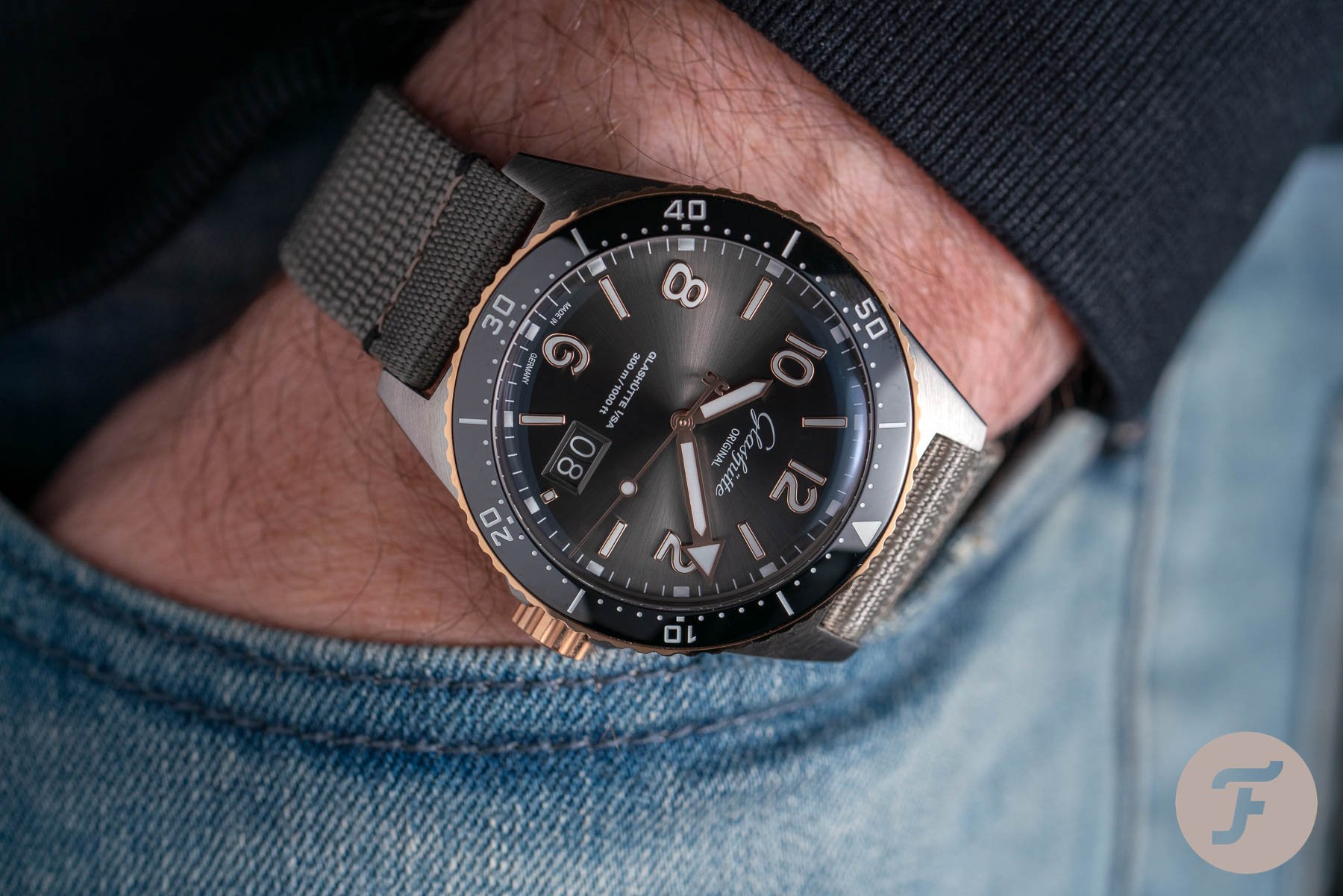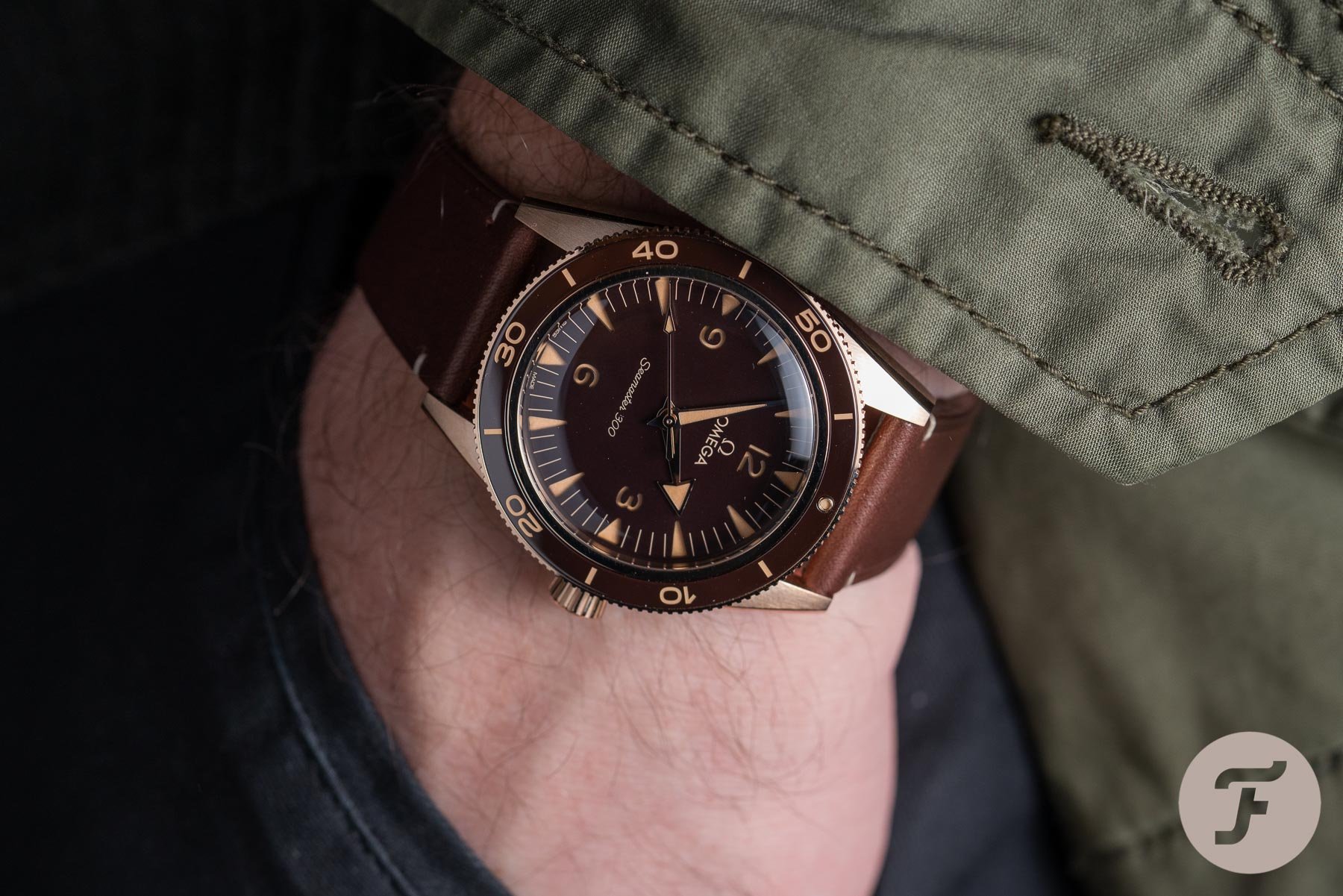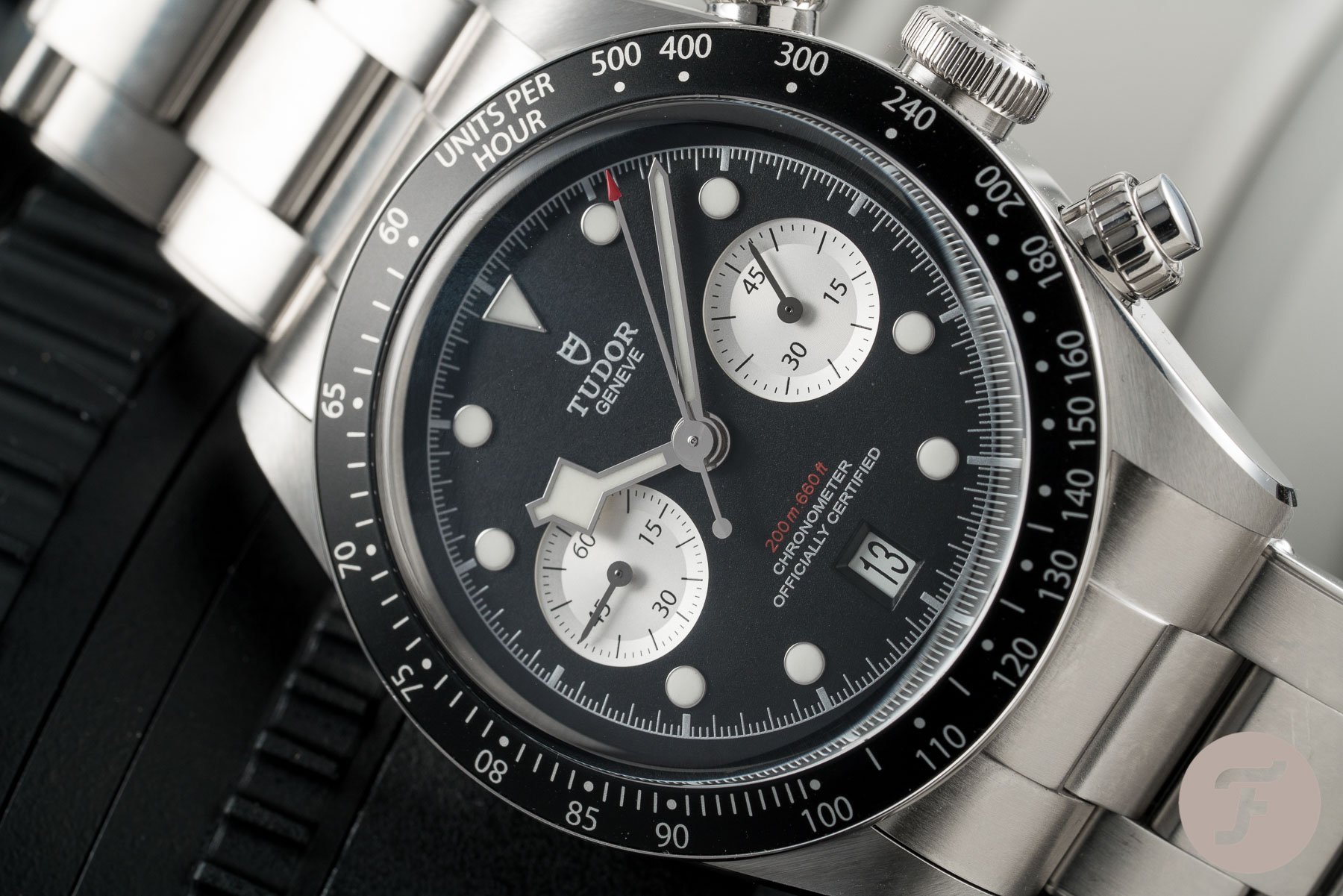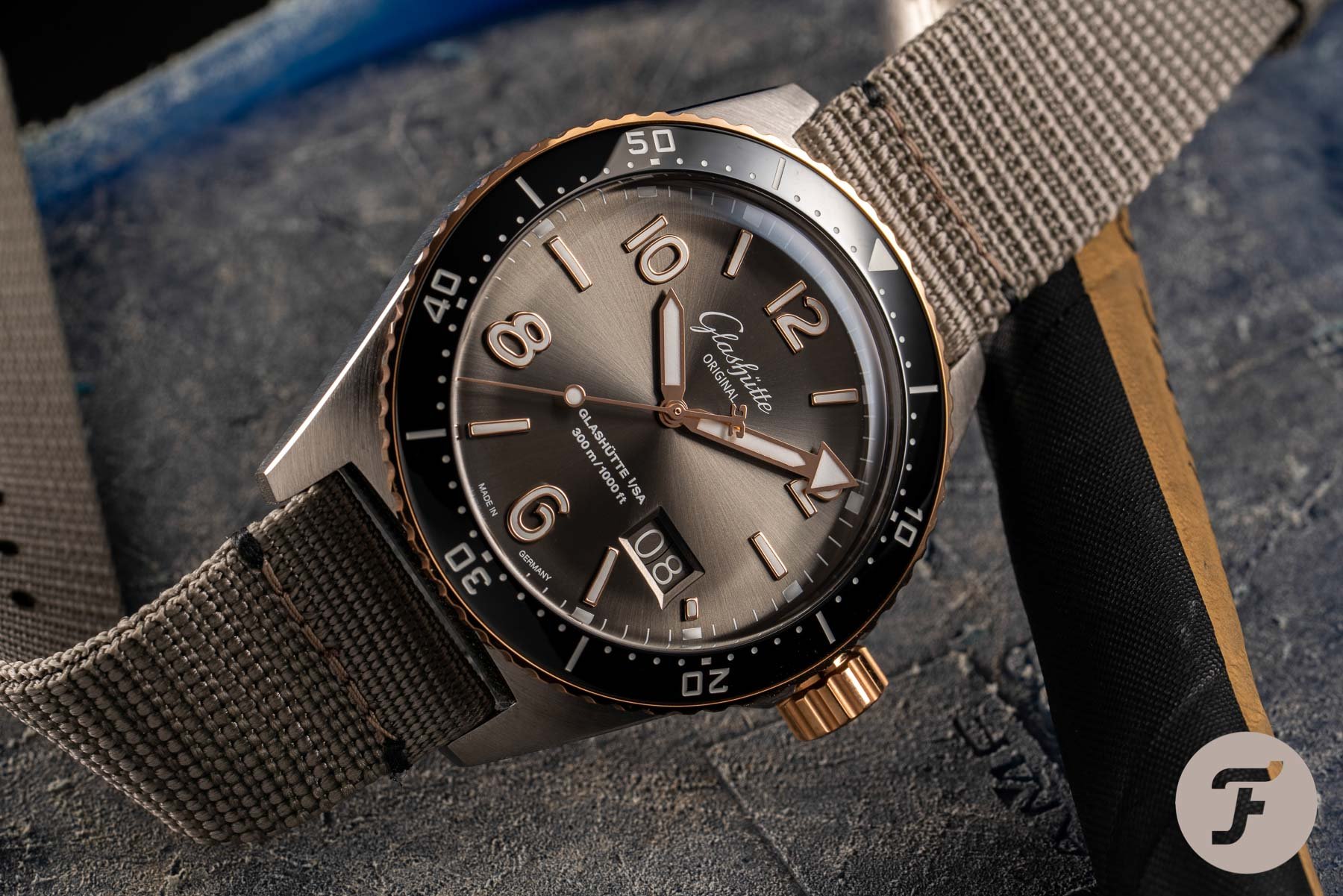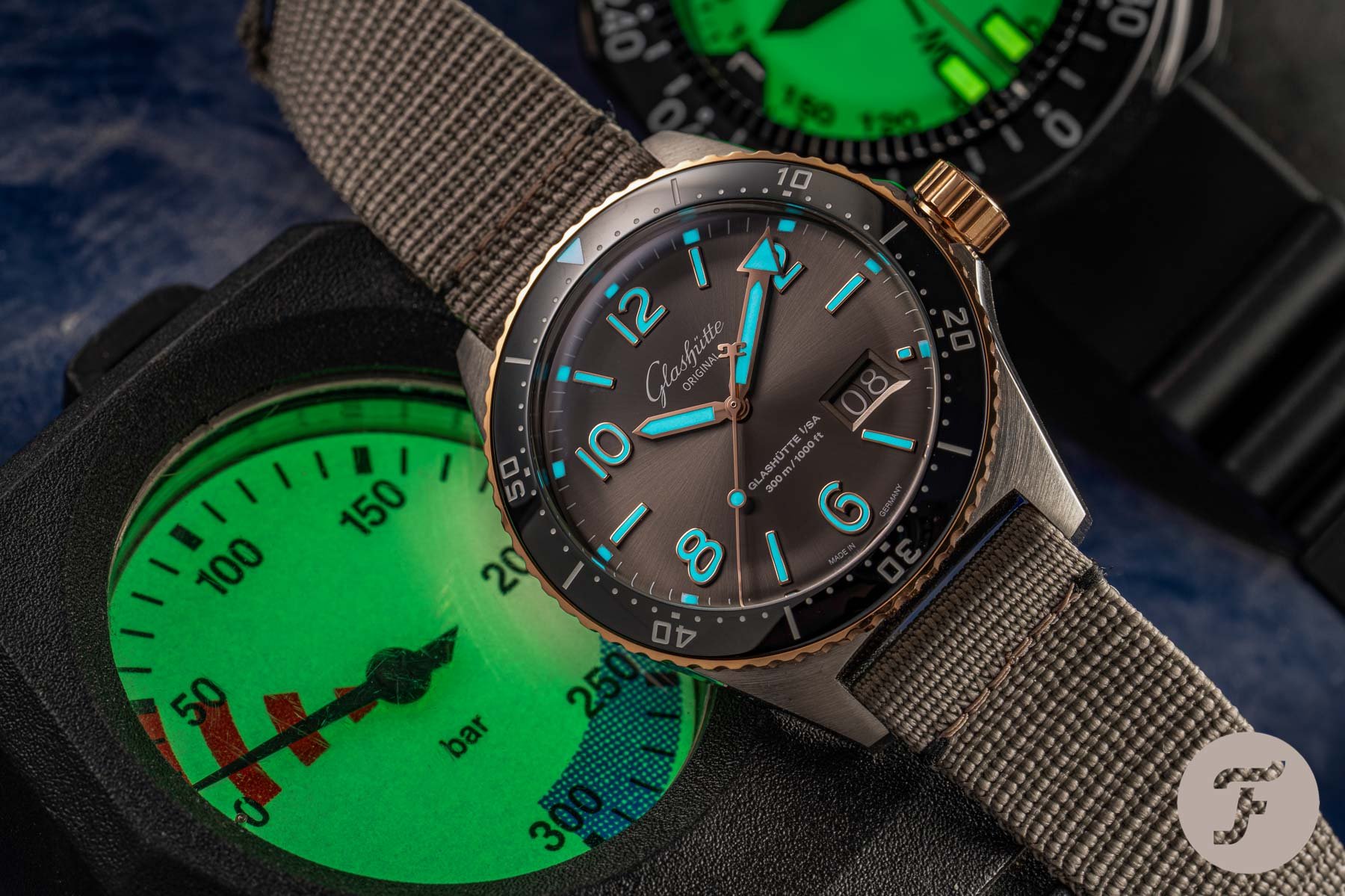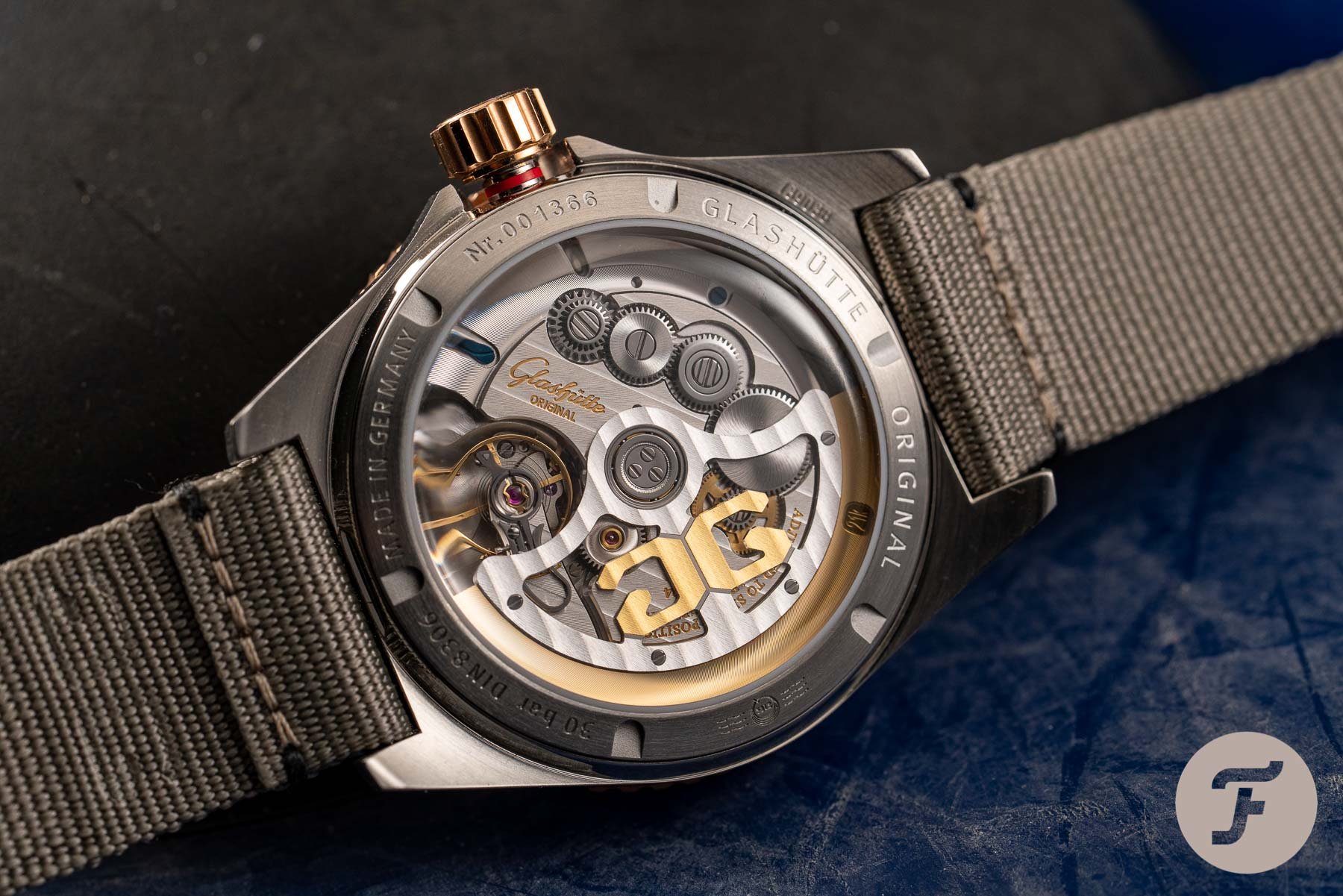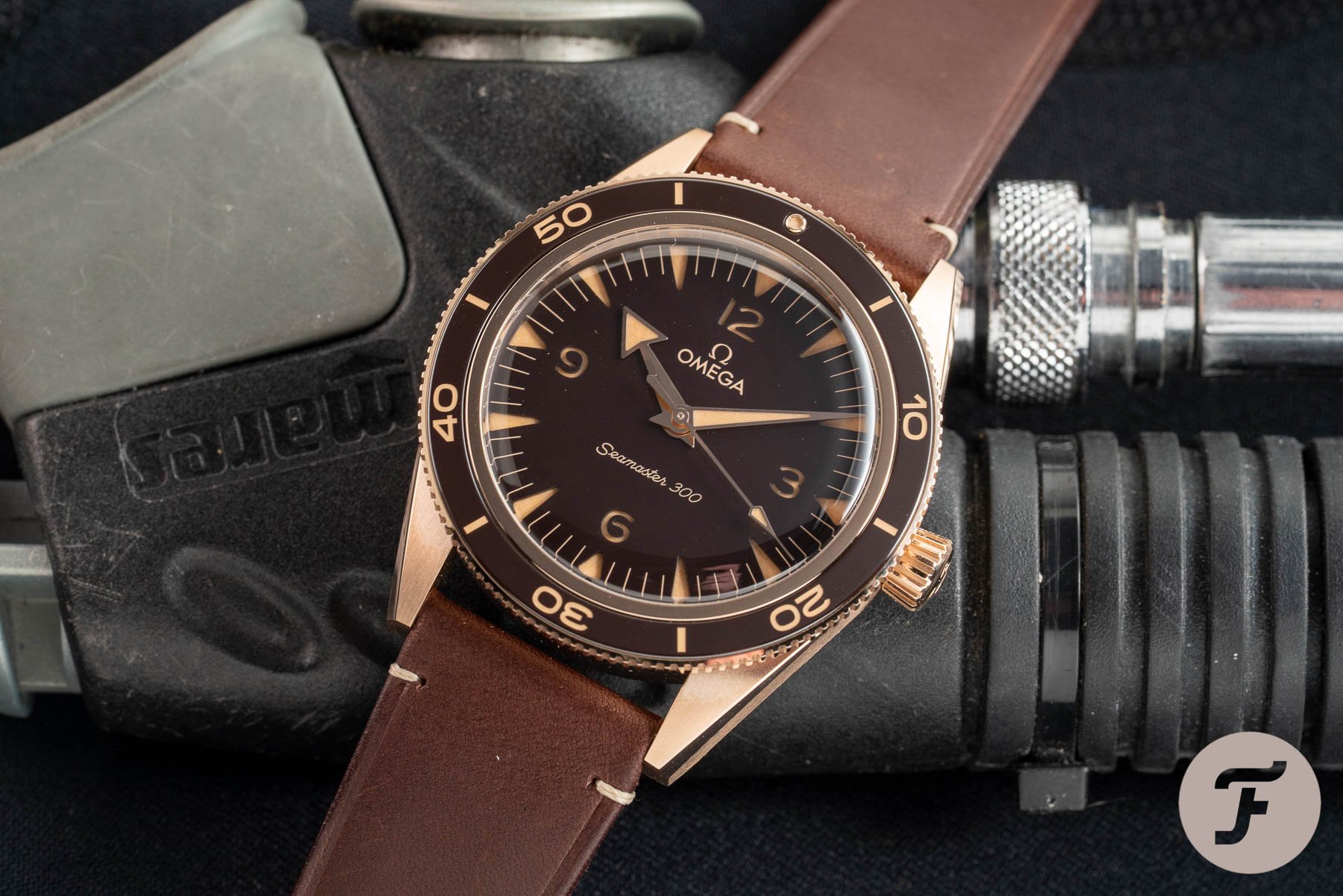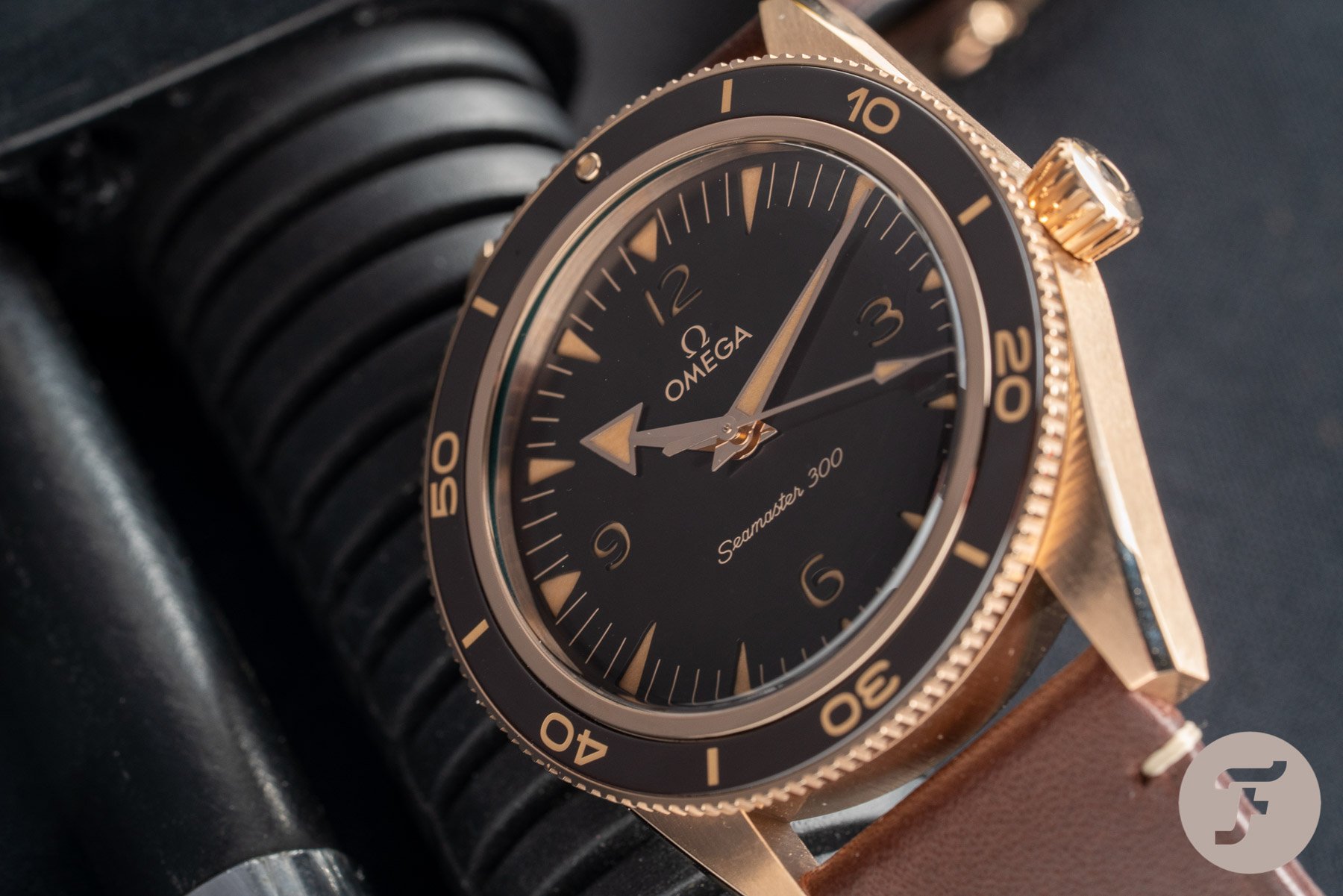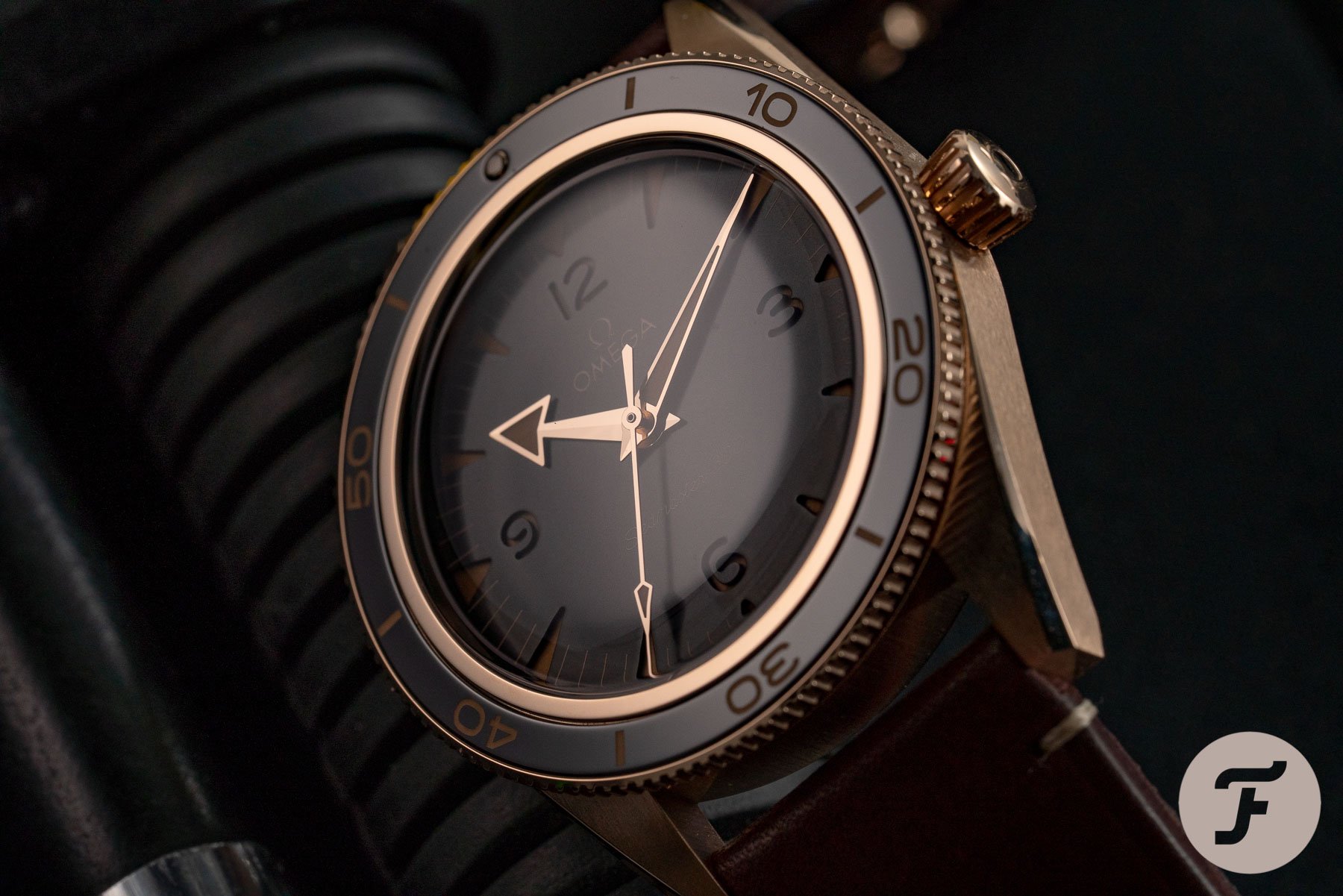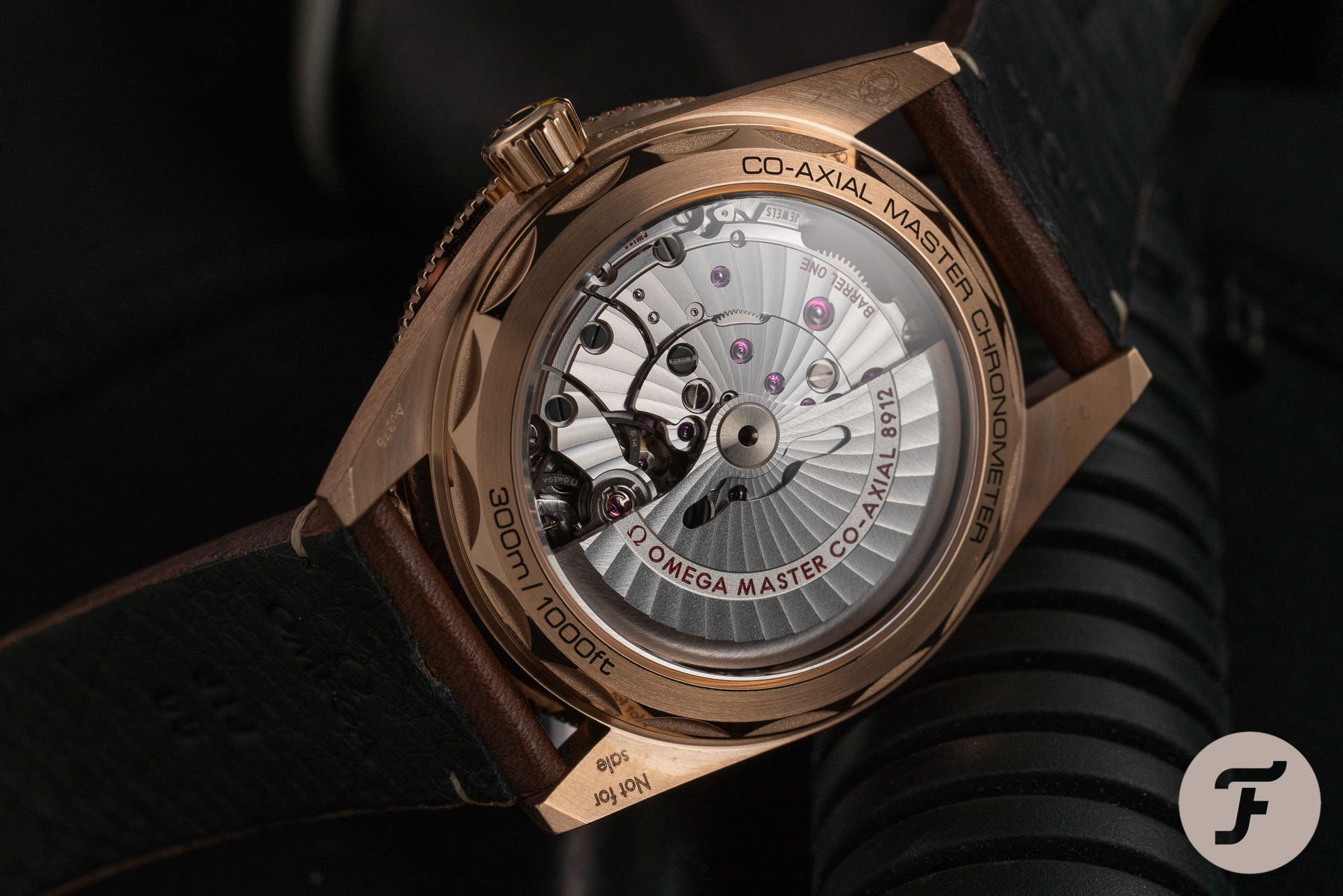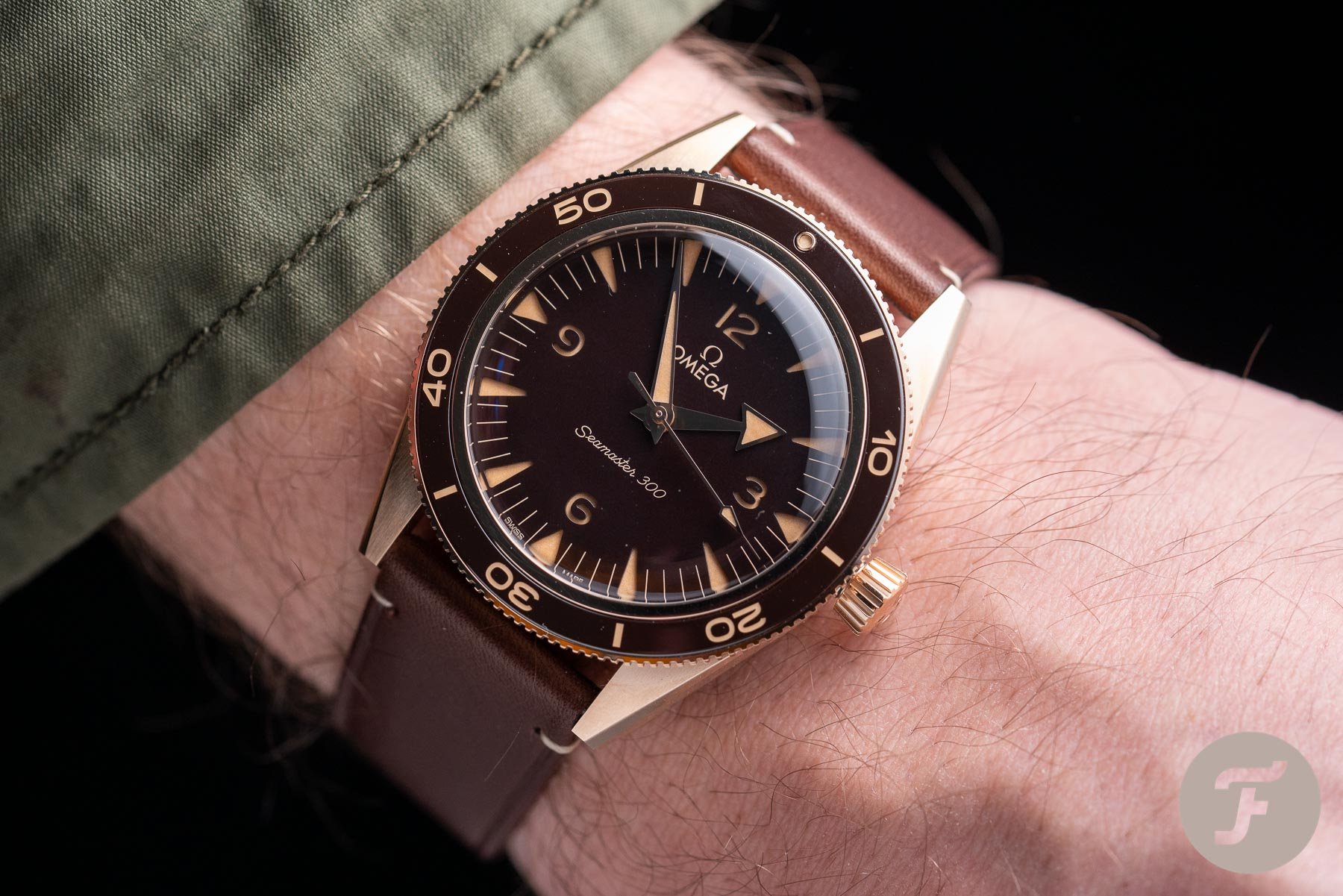Omega Vs. Glashütte Original: Luxury Dive Watches With A Hint Of Gold
In our Sunday Morning Showdown, two of our writers go head-to-head in an epic showdown for the ages. Strong opinions and hysterical hyperbole are welcome (so feel free to join in with the fun in the comments section below). And don’t forget to let us know which watches you’d like to see torn to shreds/effusively exalted next week. We’ll try and feature as many of our readers’ choices as we can. In today’s episode, we set out on a grand voyage for exotic dive watches over €10,000. The new 2021 Omega Seamaster 300 in Bronze Gold takes on the Glashütte Original SeaQ Panorama Date.
Again we are selecting a new 2021 watch for our Sunday Morning Showdown series. But this time, the contender was not part of the Watches & Wonders 2021 event. The Seamaster 300 Bronze Gold was instead unveiled under the direct control of Omega. It’s a burgeoning trend for manufacturers to not rely on trade shows to dictate the release schedule. This way, the brand sets the dates that work for its products. This is better than being caught up in the hysteria of a simultaneous announcement during an event. I am all for this approach that allows the spread of watch releases over the year and avoids the mad dash for supremacy.
Focus on the new Seamaster 300
Following the new Moonwatch in January, the first Tuesday of 2021, Omega gave us updates to the Seamaster, Constellation, and DeVille range for March. We covered the whole suite of watches with live pictures and video. Amongst the new watches, the revised Seamaster 300 emerged as the standout. The Seamaster leaned even more to its heritage side with a pared-back dial, lollipop seconds hand, and a sandwich lume. Despite the vintage charm, the Caliber 8912 within was modernized to receive Master Chronometer certification. While the outgoing generation was called the Master Co-Axial Chronometer, it was not a Master Chronometer — confusing, I know. The previous reference certainly had the credentials, but it did not undergo the same rigorous METAS tests as the new generation has now undertaken.
- Glashütte Original SeaQ Panorama Date
Glashütte Original SeaQ Panorama Date Bicolor Vs. Omega Seamaster 300 Bronze Gold
Our choice from the Seamaster 300 collection is the intriguing Bronze Gold variant. At first, it was shocking to hear Omega producing a bronze watch, but with a bit of explanation, intrigue quickly turned to fascination. The case blends 9k gold with bronze to ensure a lasting golden hue while keeping costs in reasonable territory. It’s a proprietary alloy demonstrating Omega’s willingness to innovate in material science beyond the usual suspect alloys. This version foregoes the lollipop seconds hand of the rest of the collection, and the limited edition Spectre Bond Seamaster, for a wedge-shaped hand. This carries over from the previous 300, but the Bronze Gold keeps the arrow hour hand, akin to the original CK2913 reference from 1957. The Bronze Gold also has a ceramic brown bezel to match the dial, unlike the aluminum bezels of its steel variants.
To match it up against a similarly priced diving watch, we turned to its German contemporary, Glashütte Original. Both Omega and Glashütte Original come under the Swatch Group umbrella. So this one is an inter-team tussle. But the SeaQ Panorama Date Bicolor is more than up for the fight. The SeaQ is part of the Spezialist range that harks back to the professional ’60s and ’70s dive watches. Glashütte Original brought the style back to life in 2019 and has steadily iterated upon the core design. In 2020 we were treated to the Bicolor version with a steel case and red gold accents on the bezel and crown. The sunburst grey dial harmonized the dial aspects that had previously appeared flat in the monotone dial versions. More than just a luxury flaunt, the SeaQ boasts a water resistance of 300 meters, equalling that of the namesake Seamaster 300.
Tudor takes the chequered flag
I’m not sure Ben can take any more of this misery, with Jorg’s second win in a row. The TAG Heuer Carrera was no match for the new kid on the (big) block. The Tudor Black Bay Chrono took a decisive win with 68% of the voting share. Although, it was pointed out in the comments that it was the lesser of two evils in last week’s match-up. Many suggested higher-priced offerings from other brands, but the question was if Tudor has taken the crown from TAG Heuer. The answer, at least for both brand’s premiere chronograph model, is an emphatic yes. But TAG still has the chance to move up the grid and retake the lead.
Back to our discussion for today, and we’ll see who will be victorious.
Ben — Glashütte Original SeaQ Panorama Date
When looking for a worthy adversary for the Seamaster 300, it took a while for me to summon the Glashütte Original SeaQ. We knew the Seamaster 300, especially in the Bronze Gold guise, was asserting itself in a higher price bracket. But we also needed to match the credentials and not just land on an obvious dive watch but in two-tone. It seems evident with the SeaQ now, but there’s something about Glashütte Original that prevents it from being at the forefront of my internal watch brand Rolodex. It’s an accomplished marque with many exciting timepieces in its collection, but it doesn’t yet feel like it’s a household name. The SeaQ is intended as that watch to break through that barrier and become a halo-piece for GO.
Jorg: Even though this is a showdown for the ages, I fully agree with you Ben. The SeaQ collection deserves to be a prominent collection for the brand.
The Seamaster 300 eschews the date window, whereas the Glashütte Original prominently features the date aperture at the 4 o’clock position. But this isn’t one of those cases where the date is an afterthought. Nor is just a hole unceremoniously punched through a gloriously symmetrical dial. The Panorama Date version of the SeaQ makes a spectacle of the date function. The outsized date has two discs beneath the dial per index. This way, the date is significant and visible without a distorting cyclops. This configuration also allows for the date numerals to sit on the same plain rather than the different levels as per the A. Lange & Söhne Lange 1.
Arrow aiming at the bullseye
An interesting quirk about both today’s dive watches is the arrow hand on each watch. The Seamaster 300 places the arrowhead on the hour hand. Conversely, the Glashütte elects to place this motif on the minute hand. The Seamaster 300 provides this layout for heritage purposes. At the same time, the SeaQ emphasizes functionality. In diving compression rests, the minute hand is the most crucial indication. During an ascent, the diver must equalize with the relative pressure. The uni-directional bezel of the SeaQ can rotate to the current minute count. The diver then awaits the appropriate time to continue the ascent. Having the minute hand appear as the most predominant aspect of the dial reduces the risk of mistaken identity with the other indicators.
Jorg: Are you sure it’s not that ludicrously big date window that is the most prominent?
Ben: Unlike the smaller SeaQ model, the Panorama Date has applied oversized gold numerals filled with generous amounts of Super-LumiNova. This higher-end attention also extends to the Caliber 36-13, with refined finishing techniques. The skeletonized rotor features the Glashütte Original logo with a 21k red gold weight on the outer part. Viewing further through the sapphire crystal case-back, you can observe the bevelling on the bridges, the snailing on the gears, and broad Glashütte ribbing. You may think this level of craft distracts from its diving robustness. But Glashütte inflicts each cased movement with sufficient tests against heavy shocks and magnetic exposure throughout 24-days. It certainly gives METAS a run for its money.
The ideal sailing watch
The SeaQ Panorama Date has a 43.2mm case, which does dwarf the 41mm Seamaster 300. And it’s not like the remaining dimensions make up for it, with a thickness of 15.65mm. But in Bicolor with a grey dial, it elevates all the components so that each part gets a starring role. I pictured myself owning this piece. Other than the apparent diving excursions, I more attributed this watch to helming a sailing yacht. And looking at the specs, it indeed had the capability for the high seas. A luxury three-hander and a healthy 300-meter water resistance suit the core requirements. But even then, it still needs some thought.
Winching and hoisting can take a toll on full bracelet watches, so the textile folding strap is a good choice to withstand the wear and tear of sailing. Then there’s the case material. Lightness is helpful but can fool you into thinking it’s still on your wrist, when in fact, your watch came loose 100-kilometers behind and is now sinking to the seabed. The reassuring heft of a steel watch with the touches of gold on the bezel and screw-down crown is a good reminder that it’s still on the wrist. The luxurious sunburst grey dial and domed sapphire crystal would also be perfect for watching the sunset from the deck.
While I’m sailing into the sunset, Jorg, how about you take the audience on a trip to the deep.
Jorg — Omega Seamaster 300 Bronze Gold
I’ll be glad to, Ben. However, I must say that while bronze is very much associated with the depths of the seas. The Bronze Gold Seamaster 300 feels much more at home on the wrist watching that same sunset you referred to. But before we drift off to the ending of this story, let’s start at the beginning. When Omega sent us the new Seamaster 300 models for review, I was curious to find out what the brand had come up with.
After the Speedmaster, the Seamaster 300 is my favorite Omega family of watches. And with the previous generation, Omega graced us with some fantastic pieces. The most iconic is probably the Seamaster 300 “Spectre” that comfortably beat the current Seamaster Diver 300M “No Time To Die” in a previous installment of our Sunday Morning Showdown. And my favorite is, without a doubt, the version that is part of the 1957 Trilogy.
But no matter how great these limited editions are, it all starts with the standard stainless steel model. In my opinion, it perfectly showed how well Omega did with respecting the original design from the fifties and still come up with a tremendous modern-day timepiece. It felt crisp and relevant to introducing the new generation Seamaster 300 just a few weeks ago.
First steel, then bronze
So when the new Seamaster 300 models arrived at the Fratello offices, all my attention was focused on the stainless steel models and how Omega updated them. My honest first reaction was: “do I like the smaller bezel and the 1mm bigger dial aperture?” But after that, I quickly noticed how the team at Omega did some significant updates that take the design to the next level. The sandwich dial is brilliant, aligning the colors used for the bezel and dial is smart, cleaning up the dial is excellent, the new stainless steel bracelet is very comfortable, and the re-introduction of the iconic lollipop hand a superb discussion point. So the new Seamaster is not just an update; it’s a new and improved take on the original Seamaster 300 from 1957.
But I must admit that my initial comparison was rather clinical. An observation of elements changed to come up with a mathematical equation, as you will. I liked the updates, but I didn’t love them. That all changed when I put the new Bronze Gold Seamaster 300 on my wrist for some wrist shots. That’s where I felt the emotional click with the new Seamaster 300. All the design changes came together — minus the lollipop hand — in combination with the Bronze Gold case and the brilliant brown dial and ceramic bezel. It’s a statement that can only be described as classy.
More gold than bronze
While the classy statement is an amalgamation of the different elements, it starts with the 41mm Bronze Gold case. The Bronze Gold alloy that consists of copper, 9-karat gold, silver, gallium, and palladium feels more like a gold case than a bronze case. As Robert-Jan perfectly explained in his watch review, its color sits between Moonshine gold and Sedna gold. It turns out to be the perfect canvas for the brown sandwich dial and ceramic bezel. While the watch already looks great in the pictures, the sunlight is where it truly shines. Put it on your wrist with the brown calf leather strap, and it’s hard to take it off.
Out on the deck
If you turn the watch around, the in-house developed caliber 8912 reveals itself to the world. Caliber 8912 operates at an unusual 25,200vph and features a 60-hour power reserve. The movement is Master Chronometer certified by METAS with an average daily performance of 0/+5 seconds. On top of that, it is anti-magnetic to at least 15,000 gauss. It’s a welcome update, and combined with the 300-meter water resistance; it makes sure the Bronze Gold Seamaster 300 is equipped for the task of exploring the deep.
However, I’m pretty sure it won’t see much of the deep blue seas. No, on the wrist while watching the sunset is a better environment for the Seamaster 300 Bronze Gold to shine. With a 41mm diameter, a height of 14.4mm, and a lug-to-lug of 48mm, it will sit perfectly on the wrist of a wide array of enthusiasts.
And fortunately, it doesn’t form the patina that usually comes with bronze. I am not a fan of bronze watches, probably explaining why I had no overwhelming desire to check out this version of the Seamaster 300. But I must admit, I was proven wrong because this is no ordinary bronze watch. The Omega Seamaster 300 Bronze Gold is the outcome of clever design and brilliant engineering. As a result, the watch is a bronze statement that has the allure of gold.
- Glashütte Original SeaQ Panorama Date Bicolor
Final Thoughts
Ben: Up until last week, I would be fighting tooth and nail for the SeaQ. I saw the announcement and the live pictures on Fratello and was not immediately blown away by the new Seamaster 300. Of the bunch, the Bronze Gold was the most interesting but my least favorite. I also thought the blue version looked like a Hasbro toy. But last week, I had the chance to go hands-on with the Bronze Gold Seamaster 300. And I’m smitten.
Jorg: Likewise, I thought it would be tough to go up against the Glashütte SeaQ because I love that collection. However, the SeaQ Panorama Date is my least favorite model. Yes, the finishing is immaculate, and the movement spectacular. But the case size is more extensive than I prefer, and the gigantic date window might be characteristic; I am constantly asking myself why a date window needs to be so big? No, I much prefer its smaller brother that leaves that quirky detail for a regular date window.
Ben: I’m afraid I have to disagree with you. Glashütte Original is all about excellence and refinement. That’s why it is so proud of that “Original” moniker. The Panorama Date offers that typical level of GO finishing in an approachable format. The small version frankly provides nothing other than being the entry-level option. While I admit the Seamaster 300 in Bronze Gold is an alluring watch, the SeaQ takes you to the next level of watchmaking yet still retains tool watch capability.
Jorg: Well, when comparing prices, the new Seamaster 300 Bronze Gold is a fitting match-up for your bicolor SeaQ Panorama Date. The Seamaster 300 Bronze Gold is available for €11,500, while the SeaQ Panorama Date is more expensive at €14,800. But after having experienced both the Seamaster 300 Bronze Gold and the bicolor SeaQ Panorama Date up close, I have to say that the natural match for the Seamaster in terms of impact is the SeaQ Panorama Date in rose gold that will set you back €25,000. That’s how strong a statement the new Omega Seamaster 300 Bronze Gold is.
But what do our readers think? Vote now and make your voices heard in the comments below.

